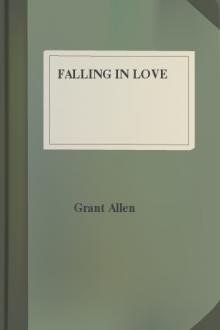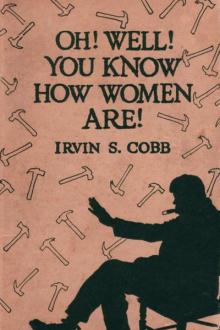Falling in Love by Grant Allen (different e readers .txt) 📕

- Author: Grant Allen
- Performer: -
Book online «Falling in Love by Grant Allen (different e readers .txt) 📕». Author Grant Allen
Let it not for a moment be supposed, however, that I wish to treat the useful and ornamental banana with intentional disrespect. On the contrary, I cherish for it—at a distance—feelings of the highest esteem and admiration. We are so parochial in our views, taking us as a species, that I dare say very few English people really know how immensely useful a plant is the common banana. To most of us it envisages itself merely as a curious tropical fruit, largely imported at Covent Garden, and a capital thing to stick on one of the tall dessert-dishes when you give a dinner-party, because it looks delightfully foreign, and just serves to balance the pine-apple at the opposite end of the hospitable mahogany. Perhaps such innocent readers will be surprised to learn that bananas and plantains supply the principal food-stuff of a far larger fraction of the human race than that which is supported by wheaten bread. They form the veritable staff of life to the inhabitants of both eastern and western tropics. What the potato is to the degenerate descendant of Celtic kings; what the oat is to the kilted Highlandman; what rice is to the Bengalee, and Indian corn to the American negro, that is the muse of sages (I translate literally from the immortal Swede) to African savages and Brazilian slaves. Humboldt calculated that an acre of bananas would supply a greater quantity of solid food to hungry humanity than could possibly be extracted from the same extent of cultivated ground by any other known plant. So you see the question is no small one; to sing the praise of this Linnæan muse is a task well worthy of the Pierian muses.
Do you know the outer look and aspect of the banana plant? If not, then you have never voyaged to those delusive tropics. Tropical vegetation, as ordinarily understood by poets and painters, consists entirely of the coco-nut palm and the banana bush. Do you wish to paint a beautiful picture of a rich ambrosial tropical island, à la Tennyson—a summer isle of Eden lying in dark purple spheres of sea?—then you introduce a group of coco-nuts, whispering in odorous heights of even, in the very foreground of your pretty sketch, just to let your public understand at a glance that these are the delicious poetical tropics. Do you desire to create an ideal paradise, à la Bernardin de St. Pierre, where idyllic Virginies die of pure modesty rather than appear before the eyes of their beloved but unwedded Pauls in a lace-bedraped peignoir?—then you strike the keynote by sticking in the middle distance a hut or cottage, overshadowed by the broad and graceful foliage of the picturesque banana. ('Hut' is a poor and chilly word for these glowing descriptions, far inferior to the pretty and high-sounding original chaumière.) That is how we do the tropics when we want to work upon the emotions of the reader. But it is all a delicate theatrical illusion; a trick of art meant to deceive and impose upon the unwary who have never been there, and would like to think it all genuine. In reality, nine times out of ten, you might cast your eyes casually around you in any tropical valley, and, if there didn't happen to be a native cottage with a coco-nut grove and banana patch anywhere in the neighbourhood, you would see nothing in the way of vegetation which you mightn't see at home any day in Europe. But what painter would ever venture to paint the tropics without the palm trees? He might just as well try to paint the desert without the camels, or to represent St. Sebastian without a sheaf of arrows sticking unperceived in the calm centre of his unruffled bosom, to mark and emphasise his Sebastianic personality.
Still, I will frankly admit that the banana itself, with its practically almost identical relation, the plantain, is a real bit of tropical foliage. I confess to a settled prejudice against the tropics generally, but I allow the sunsets, the coco-nuts, and the bananas. The true stem creeps underground, and sends up each year an upright branch, thickly covered with majestic broad green leaves, somewhat like those of the canna cultivated in our gardens as 'Indian shot,' but far larger, nobler, and handsomer. They sometimes measure from six to ten feet in length, and their thick midrib and strongly marked diverging veins give them a very lordly and graceful appearance. But they are apt in practice to suffer much from the fury of the tropical storms. The wind rips the leaves up between the veins as far as the midrib in tangled tatters; so that after a good hurricane they look more like coco-nut palm leaves than like single broad masses of foliage as they ought properly to do. This, of course, is the effect of a gentle and balmy hurricane—a mere capful of wind that tears and tatters them. After a really bad storm (one of the sort when you tie ropes round your wooden house to prevent its falling bodily to pieces, I mean) the bananas are all actually blown down, and the crop for that season utterly destroyed. The apparent stem, being merely composed of the overlapping and sheathing leaf-stalks, has naturally very little stability; and the soft succulent trunk accordingly gives way forthwith at the slightest onslaught. This liability to be blown down in high winds forms the weak point of the plantain, viewed as a food-stuff crop. In the South Sea Islands, where there is little shelter, the poor Fijian, in cannibal days, often lost his one means of subsistence from this cause, and was compelled to satisfy the pangs of hunger on the plump persons of his immediate relatives. But since the introduction of Christianity, and of a dwarf stout wind-proof variety of banana, his condition in this respect, I am glad to say, has been greatly ameliorated.
By descent the banana bush is a developed tropical lily, not at all remotely allied to the common iris, only that its flowers and fruit are clustered together on a hanging spike, instead of growing solitary and separate as in the true irises. The blossoms, which, though pretty, are comparatively inconspicuous for the size of the plant, show the extraordinary persistence of the lily type; for almost all the vast number of species, more or less directly descended from the primitive lily, continue to the very end of the chapter to have six petals, six stamens, and three rows of seeds in their fruits or capsules. But practical man, with his eye always steadily fixed on the one important quality of edibility—the sum and substance to most people of all botanical research—has confined his attention almost entirely to the fruit of the banana. In all essentials (other than the systematically unimportant one just alluded to) the banana fruit in its original state exactly resembles the capsule of the iris—that pretty pod that divides in three when ripe, and shows the delicate orange-coated seeds lying in triple rows within—only, in the banana, the fruit does not open; in the sweet language of technical botany, it is an indehiscent capsule; and the seeds, instead of standing separate and distinct, as in the iris, are embedded in a soft and pulpy substance which forms the edible and practical part of the entire arrangement.
This is the proper appearance of the original and natural banana, before it has been taken in hand and cultivated by tropical man. When cut across the middle, it ought to show three rows of seeds, interspersed with pulp, and faintly preserving some dim memory of the dividing wall which once separated them. In practice, however, the banana differs widely from this theoretical ideal, as practice often will differ from theory; for it has been so long cultivated and selected by man—being probably one of the very oldest, if not actually quite the oldest, of domesticated plants—that it has all but lost the original habit of producing seeds. This is a common effect of cultivation on fruits, and it is of course deliberately aimed at by horticulturists, as the seeds are generally a nuisance, regarded from the point of view of the eater, and their absence improves the fruit, as long as one can manage to get along somehow without them. In the pretty little Tangierine oranges (so ingeniously corrupted by fruiterers into mandarins) the seeds have almost been cultivated out; in the best pine-apples, and in the small grapes known in the dried state as currants, they have quite disappeared; while in some varieties of pears they survive only in the form of shrivelled, barren, and useless pips. But the banana, more than any other plant we know of, has managed for many centuries to do without seeds altogether. The cultivated sort, especially in America, is quite seedless, and the plants are propagated entirely by suckers.
Still, you can never wholly circumvent nature. Expel her with a pitchfork, tamen usque recurrit. Now nature has settled that the right way to propagate plants is by means of seedlings. Strictly speaking, indeed, it is the only way; the other modes of growth from bulbs or cuttings are not really propagation, but mere reduplication by splitting, as when you chop a worm in two, and a couple of worms wriggle off contentedly forthwith in either direction. Just so when you divide a plant by cuttings, suckers, slips, or runners; the two apparent plants thus produced are in the last resort only separate parts of the same individual—one and indivisible, like the French Republic. Seedlings are absolutely distinct individuals; they are the product of the pollen of one plant and the ovules of another, and they start afresh in life with some chance of being fairly free from the hereditary taints or personal failings of either parent. But cuttings or suckers are only the same old plant over and over again in fresh circumstances, transplanted as it were, but not truly renovated or rejuvenescent. That is the real reason why our potatoes are now all going to—well, the same place as the army has been going ever since the earliest memories of the oldest officer in the whole service. We have gone on growing potatoes over and over again from the tubers alone, and hardly ever from seed, till the whole constitution of the potato kind has become permanently enfeebled by old age and dotage. The eyes (as farmers call them) are only buds or underground branches; and to plant potatoes as we usually do is nothing more than to multiply the apparent scions by fission. Odd as it may sound to say so, all the potato vines in a whole field are often, from the strict biological point of view, parts of a single much-divided individual. It is just as though one were to go on cutting up a single worm, time after time, as soon as he grew again, till at last the one original creature had multiplied into a whole colony of apparently distinct individuals. Yet, if the first worm happened to have the gout or the rheumatism (metaphorically speaking), all the other worms into which his compound personality had been divided would doubtless suffer from the same complaints throughout the whole of their joint lifetimes.
The banana, however, has very long resisted the inevitable tendency to degeneration in plants thus artificially and unhealthily propagated. Potatoes have only been in cultivation for a few hundred years; and yet the potato constitution has become so far enfeebled by the practice of growing from the tuber that the plants now fall an easy prey to potato fungus, Colorado beetles, and a thousand other persistent enemies. It is just the same with the vine—propagated too long by layers or cuttings, its health has failed entirely, and





Comments (0)